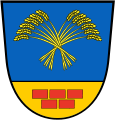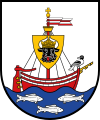Shield base
Under sign foot or foot understands Heraldiker the Herold image in heraldry that below the dividing line in the lower third of the arms is located.
Forms and uses
The base of the shield is to be understood as a bar shifted to the lower edge of the shield , with a height of about 2 ⁄ 7 to 1 ⁄ 3 of the shield height. This division contains field 7, field 8 and field 9 (foot row) after the simple shield dismantling . Field 8 is then the footer. A shield foot of thread height (about 1 ⁄ 6 shield height) is emblazoned as the base (French plaine ) . In the older heraldry, a shield foot with a reduced height was called a terrace , this is common in French and English heraldry ( terrace in base ). In French, the base of the shield is also known as champagne . The same can be found in other languages.
As with the coat of arms , the design can accommodate all colors, shapes and figures. He can rimmed (with board provided) gestückt, flamed and even after all arms cuts be of the whole shield separated.
- Many designations of the shield base design are used directly as a compound word: Example is pewter shield base , flame shield base or step shield base .
- Another possibility is to loosen up the dividing line to the upper part of the shield by designing with clover leaves, crosses, linden leaves, hearts and similar heraldic images, so that these forms are bent or drawn up to the center of the shield and thus represent a form that can be described in more detail.
Specific applications are:
- the wave foot , often, generally in blue, silver (for brooks / spray) or blue-silver in the wave cut represents water, it can also be named as a body of water ("on blue lake").
- Shield feet in green or natural color , and particularly naturally overgrown, can be emblazoned as lawns , curved as hills (this also refers to ground, terrace , French champagne 'field', English mount 'hill', and similar expressions).
- If the base of the shield is separated from the shield by three appropriately arranged arched cuts, the three mountain is created (which also appears as a free coat of arms image)
- A red tinged foot is called a regalienfeld in many large coats of arms .
Certain combinations and special forms of the situation are also known:
- If a bar is placed in the middle of the foot dividing line , it is a foot bar (shield foot bar ) . This can be increased or decreased. That depends on the position of the imaginary bar center line to the base division line.
- The sign foot is also combined with the stake or the flank and receives at the same tincture (color) a proper name: Schildfußpfahl and Schildfußflanke
- A special feature is the right-hand or left-hand angle foot . The dividing line runs diagonally from the center of the edge of the coat of arms to the base of the shield.
Herald pictures and common figures are possible in the shield base. In particular, it serves as a floor to place all kinds of figures, such as animals or structures, plants grow, or ships to swim. Whether this representation grows strictly on the dividing line , or naturalistically overlapping, and also how natural the shield base is formulated according to its meaning, is generally not determined in heraldry. Floating, on the other hand, is noted, and details of the design are emblazoned in more pictorial names ( floor, lake level, etc.). Especially the German heraldry with its little formalized blazon language leaves a lot of leeway in this regard.
Shapes of the shield base
Examples of the variety of names for the shield base
... on green ground (1) ...
( Wals-Siezenheim AT)... on pavement-like ground ... ( Abtenau AT)
... on green ground ...
( Zistersdorf AT)... on a green lawn ...
( Oberalm AT)... over a green hill ... (Bogenfuß,
Hohenfelde DE )... above a slightly moved lake level ... (Wellenfuß, (2)
Sankt Gilgen AT )











